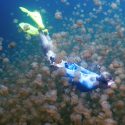At first, it’s an unsettling noise. The grinding of scales rubbing together. That’s the sound of the saw-scaled viper, the world’s deadliest snake. And it could be the last sound you ever hear.
Found in populated areas throughout India, Sri Lanka and the Middle East, saw-scaled vipers are responsible for more human deaths than all other snake species combined. While they may not have the deadliest venom, they are extremely aggressive. They strike fast. And they don’t stop after one bite. The venom can deteriorate blood vessel membranes, overwhelming your body’s blood clotting system. One nip can bleed you dry.
The venom can also rot the flesh. It practically destroys the tissue surrounding the bite. Gross. Making it through the initial encounter is one thing, but you could be faced with losing a couple of toes. Maybe even a leg. Saw-scaled vipers are mostly found in arid areas and dry savannas, especially in India, Sri Lanka and the Middle East.
This viper’s scales are oriented upward rather than backward, which is what you’ll usually see with most snakes. When threatened, it will rub its scales together. Called stridulation, this produces the telltale sawing sound that gives the species its name. That may be your only warning before you feel fangs in your flesh. So listen up! How can you avoid these sinister snakes?
What should you do if you come face-to-face with one? And why shouldn’t you try to fight back?
Step 1. Know Your Enemy
The first step in avoiding death or serious harm from a saw-scaled viper is to know how to avoid them. The species has a distinct appearance, notably their pear-shaped heads, large elliptical eyes and distinctive coloring. Their scales are oriented upward rather than backward, which is what you’ll usually see with most snakes. They are relatively small, with a maximum length of 40 cm (16 in). That makes them easy to miss. These snakes are most active on humid nights or after it rains, so that’s when you need to be extra careful.
Step 2. Wear Protection
An overwhelming majority of the snake’s bites involve the lower extremities. If you know one might be around, wear closed-toe shoes. Saw-scaled vipers often live in small holes in the rocky environments. Something a teenager in India learned the hard way. He received severe bites on his hand when reaching into such a hole while hunting bush rats. The resulting swelling led to his hand being transformed into a reddish heap of flesh that later required two fingers to be amputated. So carry some gloves. And make sure they’re thick.
Step 3. Make a Quick Exit
Because of their overly aggressive instincts, if you encounter a saw-scaled viper, the best thing to do is just get the heck out of there. Just because it’s not moving doesn’t mean there’s no danger. It has the ability to launch a leaping attack from a coiled position. And being a sidewinder, it’s extremely fast over surfaces like sand.
Back away slowly and do not make sudden movements. Don’t take your eyes off it. If you are bitten, get away from the snake immediately. They will often go in for multiple bites, and each one increases your chances of a very bad outcome. Don’t try to kill the snake. It’s not worth it.
Step 4. Beat the Clock
Direct contact means the clock is ticking. Prepare for swelling and intense pain around the bite that will spread to the rest of your body. Internal bleeding will become a major issue. Get yourself to a doctor and get an antivenom treatment. There are literally thousands of antivenoms available, so make sure to describe the snake that bit you as accurately as possible. Some victims have even killed their attacker and brought it with them. Please, don’t do this. Once treated, you should recover in a few days.
Step 5. Trust the Research
If you survive the saw-scaled viper’s venom, there’s still a risk of tissue damage or the loss of a limb. But is there any way to prevent this? After a bite, our immune system dispatches white blood cells to the site to fight off the venom. While these cells effectively kill the venom, they also starve the surrounding tissue of oxygen, leading to rot.
Researchers have begun experimenting with chemical compounds from much-deadlier cobra venom. They have had success neutralizing venom and treating tissue damage simultaneously. Unfortunately, the trials have only been successful with mice. Most people have a fear of snakes, and with good reason. Following these tips will help you live to see another day. And if going head-to-head with just one isn’t scary enough, what would you do if you were stuck on a whole island full of them?
Sources
- “9 Of The World’S Deadliest Snakes“. 2022. Encyclopedia Britannica.
- “How To Survive A Fast, Venomous, Flesh-Destroying Snake“. 2022. Science.
- “Connect. Collaborate. Express | Roundglass Living“. 2022. Roundglasssustain.Com.
- “Forklift Driver Finds Deadly Saw-Scaled Viper In Salford Brickyard“. 2021. The Guardian.
- “Indian Saw-Scaled Viper – Facts, Diet, Habitat & Pictures On Animalia.Bio“. 2022. Animalia.Bio.

















